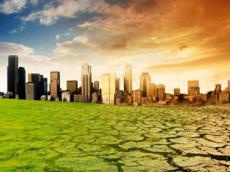|
|
TODAY.AZ / Weird / Interesting
Climate change may lead to new life forms
25 January 2014 [10:14] - TODAY.AZ
 The Earth risks losing up to 30 percent of the presently existing animal and plant species due to climate change. Researchers have found that the global climate is changing too fast for living organisms to catch up with it. At the same time, climate change may lead to the appearance of entirely new ecosystems.
The Earth risks losing up to 30 percent of the presently existing animal and plant species due to climate change. Researchers have found that the global climate is changing too fast for living organisms to catch up with it. At the same time, climate change may lead to the appearance of entirely new ecosystems.Rising temperatures, desertification and the shrinking volumes of fresh water are to blame for a decrease in biodiversity. The latest studies show that salmon populations off the North American coasts have plummeted by dozens of times in recent years. Coral reefs are on the brink of extinction. Higher atmospheric temperatures cause the depletion of nutrients and consequently the bleaching and death of corals.
Low rainfalls and hotter summers in Australia are putting kangaroos and other pouched mammals at risk. Drier and less predictable weather in Africa south of the Sahara Desert has significantly cut down elephant habitats.
Climate change alters geographic landscape. In Europe, fast-expanding forests are threatening to destroy the Alpine meadow ecosystem: the sun-loving Alpine daisy, the black Alpine sedge and other meadow grasses cannot survive in the shadow of large trees. "Some insect species and pests that normally live in the south have been found in the Moscow region. Plant diseases more characteristic of southern areas have become more common here, which makes it is safe to suggest that warm-weather southern plants are gradually moving northward. Farmers in Central Russia grow grapes and other southern fruit tree species," Kruchina told the Voice of Russia.
Higher altitudes are most prone to climate change. Melting ice sheets and seasonal snow covers are a disaster for polar species living on ice caps.
"Walruses and polar bears are the worst hit. Polar bears usually hunt on ice, but because there is fewer ice, things become critical for them during the summer season. So, they start hunting small rodents and birds and often come into villages where they are confronted by men. The number of clashes that prove fatal both for bears and humans is on the rise. Things aren't any easier for walruses. Being an ice-hunting species, they are very reluctant to go ashore," said Mikhail Stishov, WWF Russia Arctic Biodiversity Coordinator.
Global warming may eventually result in large predators becoming smaller. It already happened at least once in the past: around 55 million years ago after the extinction of dinosaurs there was an episode of intense and rapid warming. Mammals became much smaller during that period. Scientists attribute it to lack of food. High-levels of carbon dioxide reduced the amount of nutrients in plants.
Some researchers assume that modern climate change may be twice or perhaps three times as fast, which means that there is much less time for plants and animals to adapt themselves to new conditions in order to survive.
/AzerTAc/
URL: http://www.today.az/news/interesting/130286.html
 Print version
Print version
Views: 1921
Connect with us. Get latest news and updates.
See Also
- 06 December 2024 [22:20]
Are scented candles harmful to health? - 23 November 2024 [14:11]
Magnitude 4.5 earthquake hits Azerbaijan's Lachin - 20 November 2024 [23:30]
Launch vehicle with prototype of Starship made its sixth test flight - 27 October 2024 [09:00]
Fuel prices expected to rise in Sweden - 24 October 2024 [19:14]
Turkiye strikes terror targets in Iraq and Syria - 23 October 2024 [23:46]
Kazakhstan supplied almost entire volume of oil planned for 2024 to Germany in 9 months - 23 October 2024 [22:17]
Taiwan reported passage of Chinese Navy aircraft carrier near island - 23 October 2024 [21:50]
Russia remains largest oil supplier to India - 16 October 2024 [17:54]
Gamesummit co-founder shares insights on future of gaming industry in Azerbaijan [EXCLUSIVE] - 12 October 2024 [18:27]
TikTok cuts jobs, turns to AI for content moderation
Most Popular
 Europe no longer needs France: the results of Macron's failed policy
Europe no longer needs France: the results of Macron's failed policy
 Iran & Russia discuss Russian gas supplies, transit
Iran & Russia discuss Russian gas supplies, transit
 Biden's gift to Trump: what does the US 'partnership' with Armenia hide?
Biden's gift to Trump: what does the US 'partnership' with Armenia hide?
 Georgian PM Irakli Kobakhidze arrives in Azerbaijan for working visit
Georgian PM Irakli Kobakhidze arrives in Azerbaijan for working visit
 Azerbaijan strengthens ties with Ethiopia through high-level delegation visit
Azerbaijan strengthens ties with Ethiopia through high-level delegation visit
 Committee Chairman highlights customs coordination for enhanced trade & regional integration
Committee Chairman highlights customs coordination for enhanced trade & regional integration
 New leadership appointed to Azerbaijan's Innovation and Digital Development Agency
New leadership appointed to Azerbaijan's Innovation and Digital Development Agency
